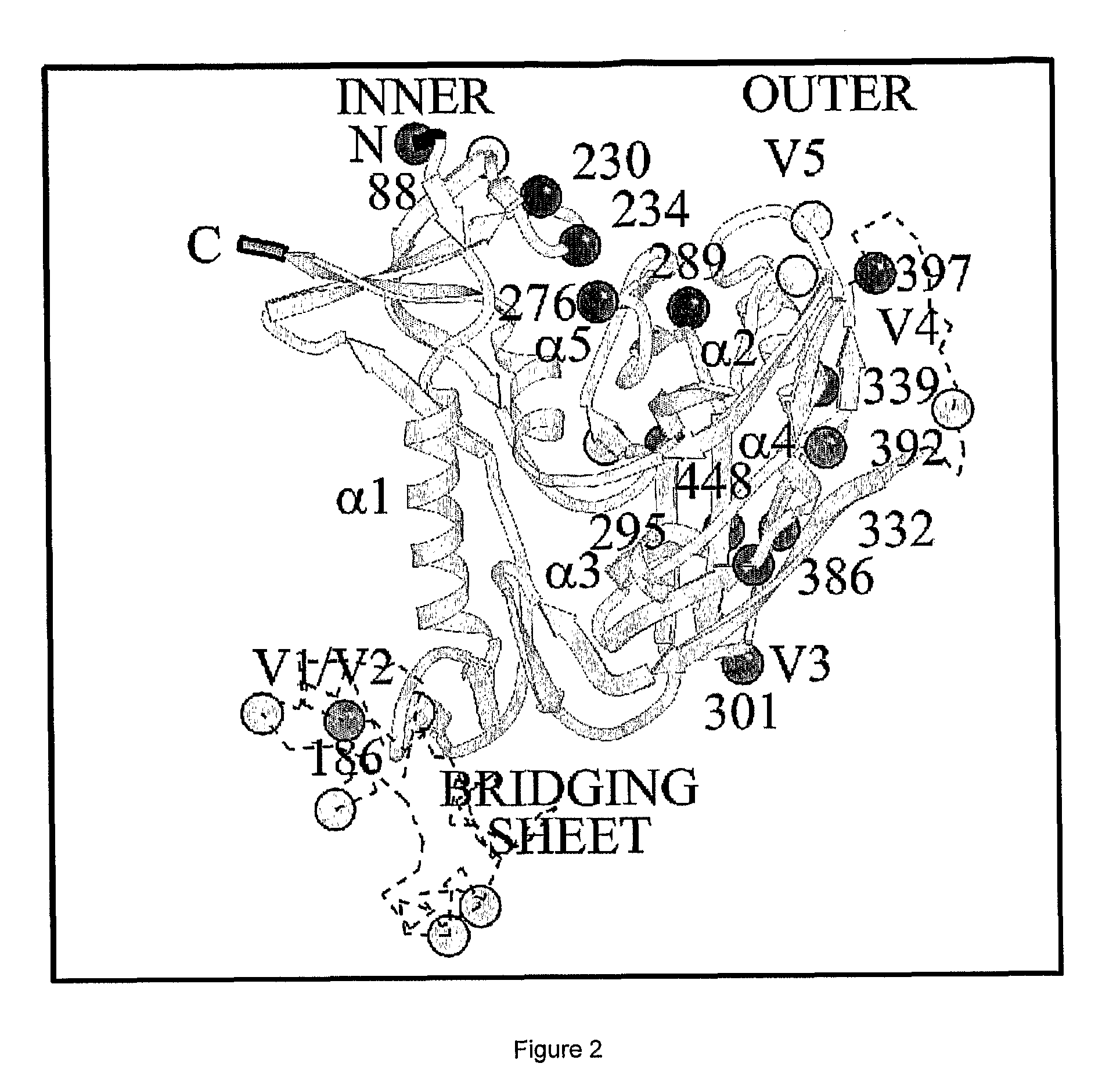Novel Antiviral Therapies
a technology of antiviral therapy and carbohydrate, which is applied in the direction of peptide/protein ingredients, extracellular fluid disorder, metabolism disorder, etc., can solve the problems of chronic carriers at risk of developing cirrhosis and/or liver cancer, major health problems worldwide for mammals including humans, and major medical problems such as viral infections
- Summary
- Abstract
- Description
- Claims
- Application Information
AI Technical Summary
Problems solved by technology
Method used
Image
Examples
example 1
General methods for Antiviral Screening
[0179]Anti-H / V assay: The inhibitory activity of compounds of the invention were be tested for their potential to inhibit the replication of HIV and SIV in a cell culture model for acute infection. Compounds were tested against HIV-1 strains (HE, NL43, MN, IIIB), HIV-2 strains (ROD, EHO, RF), and SIV (MAC251) for inhibition of virus-induced cytopathicity in MT-4 cells (or CEM or C8166 or Molt4 / C8 cells), using the colorimetric test described by Pauwels et al. in J. Virol. Methods (1988) 20:309-321 or a microscopic investigation of the cytopathogenic effect, evaluation being made 4 to 5 days post-infection. For example microtiter 96-well plates containing ˜3×105 CEM cells / ml, infected with 100 CClD50 of HIV per ml and containing appropriate dilutions of the test compounds were used.
[0180]A rapid and automated assay procedure was used for the in vitro evaluation of anti-HIV agents. An HTLV-1 transformed T4-cell line MT-4, which was previously sho...
example 2
Materials and General Preparation Methods of Carbohydrate Binding Small Molecules or Agents
[0195]The compounds of the present invention can easily be prepared by a person skilled in the art while using a series of chemical reactions known to those skilled in the art and as described in the prior art such as for
(a) porphyrins and derivatives or analogues thereof as described in Mizutani et al. (J. Am. Chem. Soc. 1997, 119: 8991-9001);
(b) phenylboronic acid comprising compounds or polymers, such as described in Uchimura et al. (Biotechnol. Bioengineer. 2001, 72: 307-314);
(c) Diethylenetriaminecopper(II) complexes, such as in Striegler (Tetrahedron 2001, 57: 2349-2354);
(d) Acyclic pyridine / pyrimidine-based carbohydrate receptors, such as in Mazik et al., (J. Am. Chem. Soc. 2005, 127: 9045-9052); and for
(e) Multivalent polyphenolic derivatives, such as in Hamashin et al. (Bioorg. Med. Chem. 2003, 11: 4991-4997);
which are all incorporated herein by reference.
[0196]Also the preparation of...
example 3
Inhibition of HIV and HCV Infection by CBA
[0197]The inhibitory activities of carbohydrate binding small molecules and agents against infectious HIV-1 (strain IIIB), HIV-2 (strain ROD) and HCVcc (subtype 2a) were evaluated in human T lymphocyte cells (CEM) and human hepatocellular carcinoma cells (Huh-7), respectively (Table 1). The mannose-specific plant lectins GNA, HHA and CA inhibited infection by both types of viruses at EC50s that varied over an order of magnitude, between 0.003 and 0.030 μM. The GlcNAc-specific plant lectin UDA and the mannose-specific non-peptidic antibiotic pradimicin A (PRM-A) also markedly inhibited HIV and HCVcc infection, although UDA was ten-fold more potent than PRM-A. There was a strong correlation between the inhibitory activity of the different CBA against both viruses (r=0.934, FIG. 4, panel A) and the potency of each CBA against HIV and HCV was within the same order of magnitude (Table 1, FIG. 4). In other words, the more inhibitory a CBA was agai...
PUM
| Property | Measurement | Unit |
|---|---|---|
| dissociation constant | aaaaa | aaaaa |
| dissociation constant | aaaaa | aaaaa |
| time | aaaaa | aaaaa |
Abstract
Description
Claims
Application Information
 Login to View More
Login to View More - R&D
- Intellectual Property
- Life Sciences
- Materials
- Tech Scout
- Unparalleled Data Quality
- Higher Quality Content
- 60% Fewer Hallucinations
Browse by: Latest US Patents, China's latest patents, Technical Efficacy Thesaurus, Application Domain, Technology Topic, Popular Technical Reports.
© 2025 PatSnap. All rights reserved.Legal|Privacy policy|Modern Slavery Act Transparency Statement|Sitemap|About US| Contact US: help@patsnap.com



